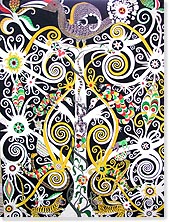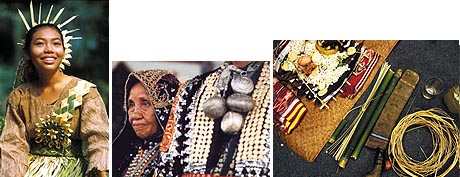|

•
Indigenous
Spiritualities
•
Hinduism
•
Chinese
Religion
•
Buddhism
•
Judaism
•
Christianity
•
Islam
•
Sikhism
•
Baha'i
Faith
|
In
Malaysia, there are more than 80 different groups of indigenous
peoples, each with their own culture and language, and each
living within their own specific traditional territory.
And because indigenous spiritualities are based on the specific
geographical and cultural contexts of these peoples, there
are as many different indigenous spiritualities as there
are distinct groups. Yet, while they may differ in their
specificities and form, they share commonality in the function
and application of their belief systems. Furthermore, there
is no such thing as conversion from one indigenous spirituality
to another. However, if an individual moves to live in another
community through marriage or some other reason, then he/she
follows the ritual of that place.
|
|
.
 Indigenous
Spiritualities Indigenous
Spiritualities
Indigenous
peoples are descendants of the earliest inhabitants who locate
themselves as a community in a specific ecological niche, which
they call their traditional or customary land. This land is the
basis of their social organisation, economic system and cultural
identification. Indigenous peoples see their traditional lands
as being imbued with a spirituality and a sacredness whose protection
and care will ensure their continued survival as a people.
Top
photo: Lun Dayeh hat: sacred energy and humankind
All indigenous
traditions and beliefs evolve as a result of living within this
specific geographical space. They are learned by participating
within a specific cultural context rather than by articulating
an abstract religious system or theology. Thus, social rules,
taboos, rituals and religious beliefs have an impact on the way
people live their everyday lives – what they eat (or cannot
eat), the way they do everyday chores, organize themselves, marry,
educate their children, treat illness, and bury the dead. These
teachings (or ancient wisdom) are usually transmitted through
oral traditions, such as in storytelling or via mythmaking, ritual
and symbolic art.
 Indigenous
spirituality, as such, brings the social, ecological, and spiritual
contexts into alignment in a way that distinguishes, but not separates,
human communities, the natural world, and the realms of the spirit
powers. Indigenous
spirituality, as such, brings the social, ecological, and spiritual
contexts into alignment in a way that distinguishes, but not separates,
human communities, the natural world, and the realms of the spirit
powers.
Tree
of Life (Kenyah)
The overriding
aspiration of all indigenous peoples is to ensure continuity and
to maintain harmony between humans and humans, between humans
and nature, and between humans and spirits. Indigenous peoples
believe that all of nature is infused with spirits or souls.
The hierarchy
of the spirit powers culminates in a Creator Being or Great Spirit.
However, this Supreme Being, while revered and honoured by the
indigenous peoples, is often distant and barely associated with
everyday human experience. It is the spirit powers who directly
communicate with, and impact, the lives of human beings, both
as individuals and as communities. They also act as intermediaries
between the Great Spirit and humans and are called upon by shamans
and healers whenever their mediation is required.
There are
both Good Spirits and Evil Spirits. While the latter bring harm,
misfortune and disease, the Good Spirits protect humans against
all these. Indigenous peoples believe that the blessings of the
Good Spirits are important for personal and community well-being.
Often, appropriate good behaviour on the part of individuals is
all that is believed to be required to maintain social harmony,
prosperity and continuity.
For indigenous
peoples, good behaviour means following and practicing values
and behaviour established by society and culture, participation
in religious rituals and traditional practices, and proper respect
for family, neighbours, and community. Failure to follow these
behavioural guidelines often results in the Good Spirits withdrawing
their blessing and protection. The result can be illness, death,
drought, or other misfortune.

From
left: Mah Meri girl in traditional dress (bark-cloth), Kadazandusun
healer; Items in Iban ritual ceremony.

|

|

